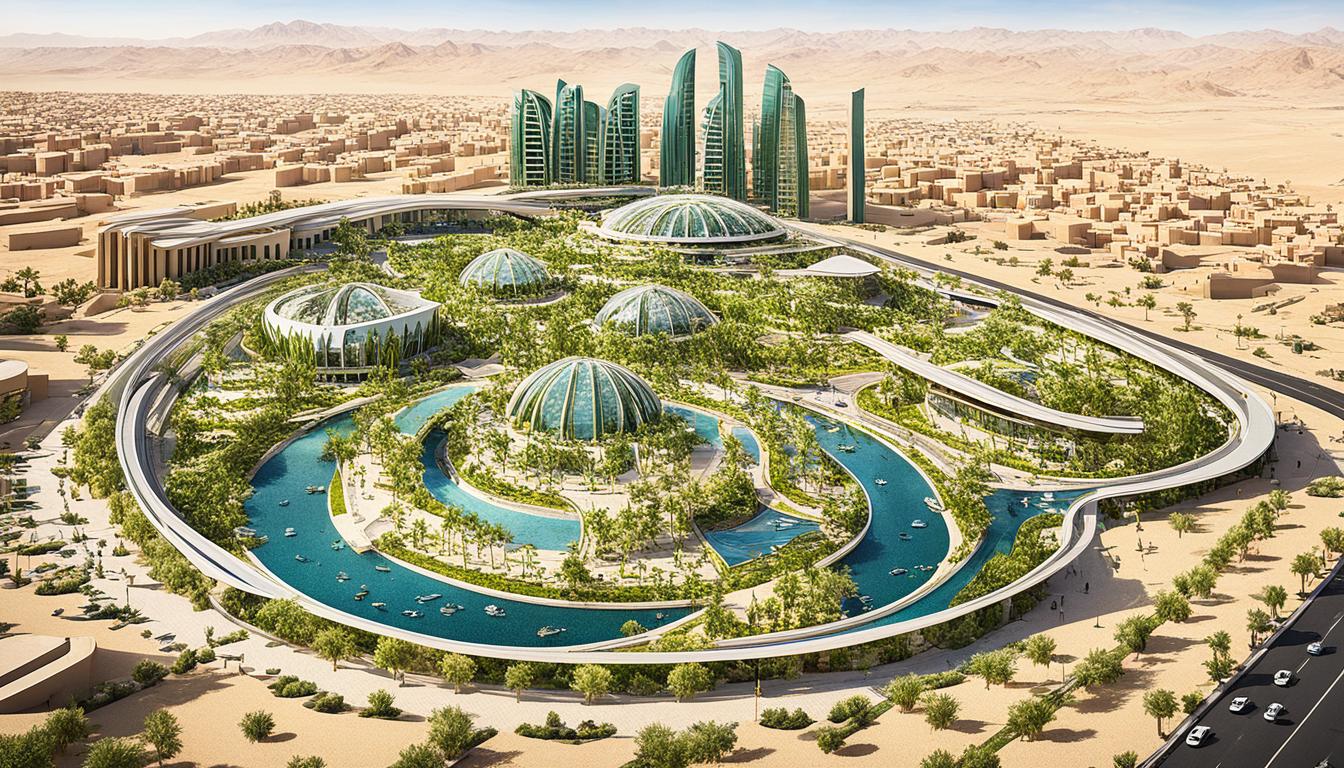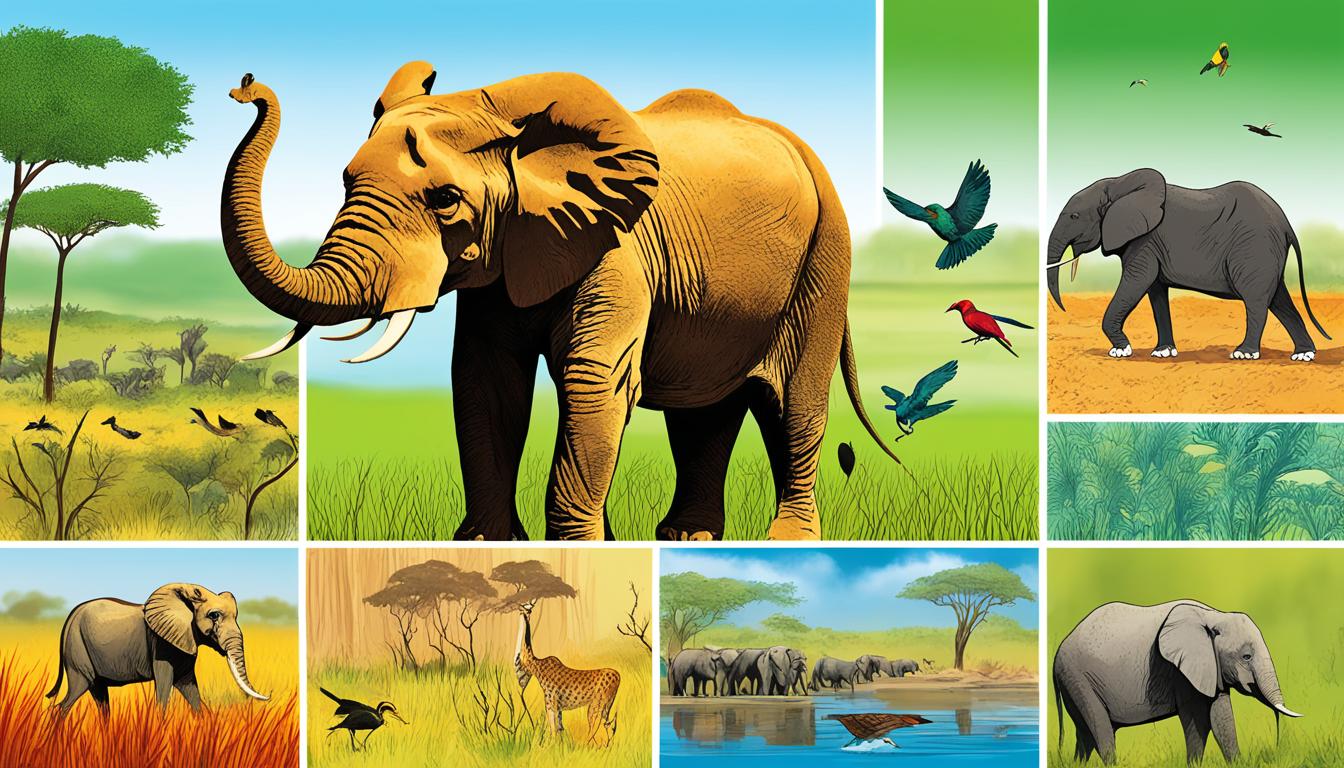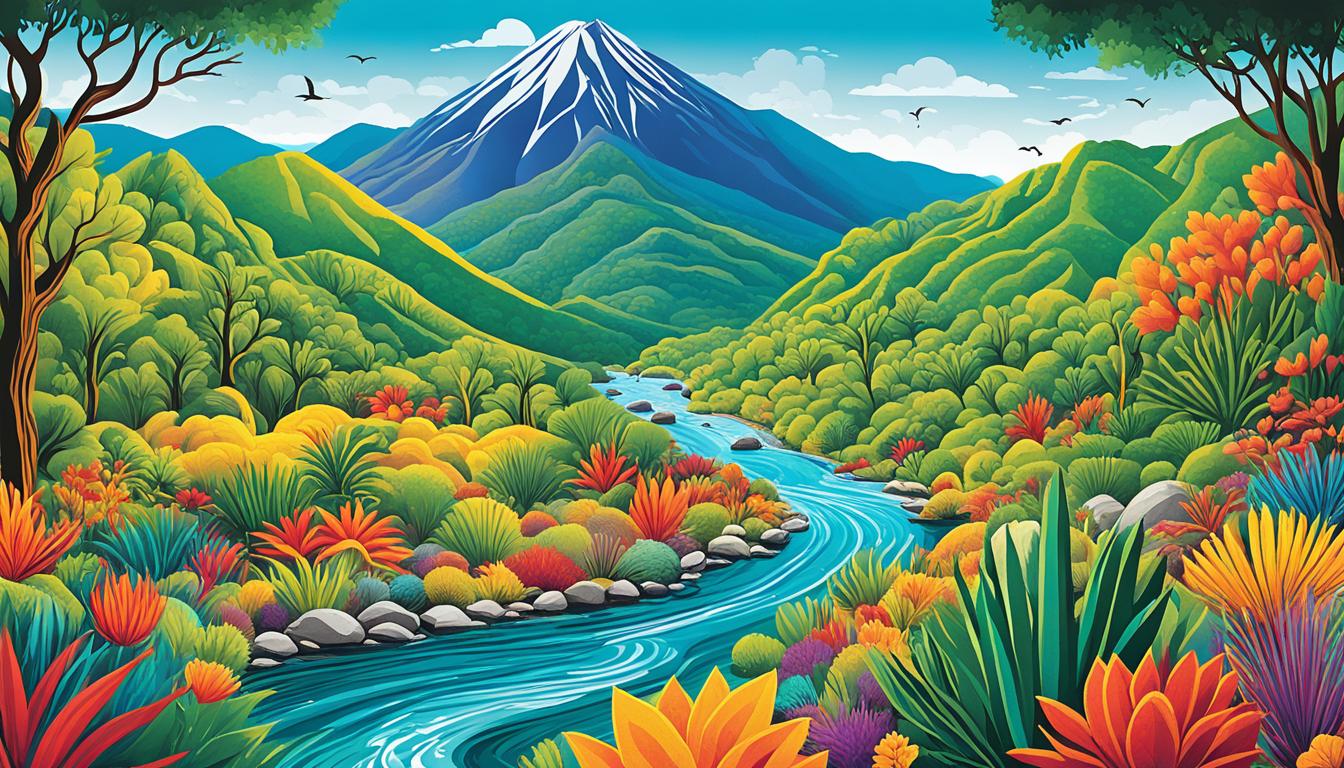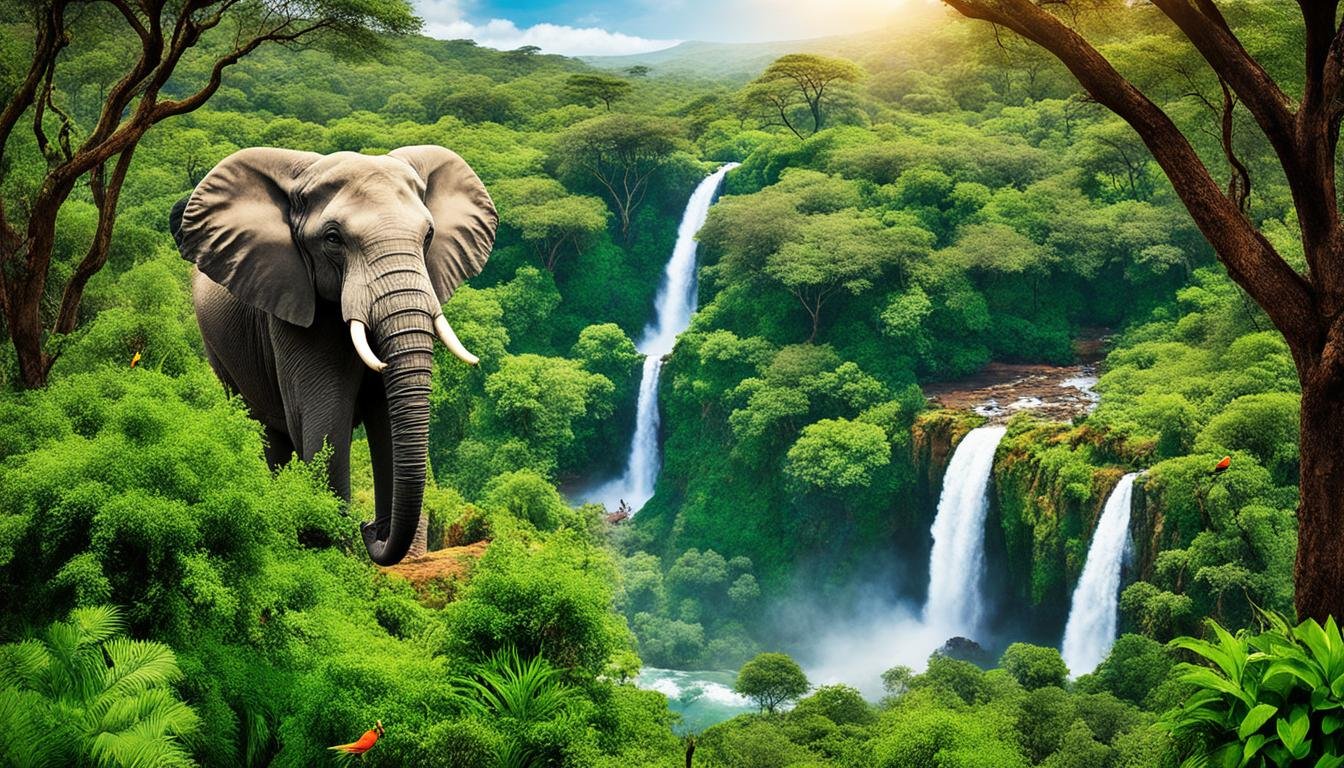Iran Biodiversity: Animal and Plant Species and What Is Under Threat
Iran is home to a remarkable array of animal and plant species, making it a haven for biodiversity. From its lush green forests to its vast deserts and coastal areas, the country boasts a diverse range of habitats that support a wide variety of wildlife. However, this rich biodiversity is facing numerous challenges and threats that put many species at risk of extinction.
Endangered Species in Iran
Key Takeaways:
- Iran is a treasure trove of biodiversity, supporting a wide range of animal and plant species.
- Many of these species are endangered and require urgent conservation efforts to ensure their survival.
- The Iranian government is committed to expanding protected areas to safeguard wildlife and their habitats.
- Collaborative efforts between the government and organizations like the Wildlife Conservation Society are vital for effective conservation.
- Climate change poses additional challenges to Iran’s biodiversity and requires long-term solutions.
The Importance of Iran’s Biodiversity
Iran’s biodiversity plays a vital role in maintaining ecological balance and sustaining natural habitats. The country’s diverse ecosystems, including ancient forests, rugged mountains, deserts, and coasts, support a wide variety of plant and animal species. This eco-diversity is not only valuable for the survival of individual species but also contributes to the overall health and resilience of the environment.
Iran’s unique blend of geographical features, from the snow-capped peaks of Damavand to the lush forests of Gilan, provides a range of habitats that support an exceptional array of flora and fauna. This natural habitat offers a sanctuary for various species to thrive and adapt to their surroundings.
One prime example is the Caspian Hyrcanian forests, a UNESCO World Heritage site known for its ancient trees and rich biodiversity. These forests are home to over 2,000 plant species and endangered animals like the Persian leopard. The preservation of such habitats is crucial for ensuring the survival of endangered species and maintaining the delicate balance of ecosystems.
“Iran’s diverse ecosystems are a treasure trove of biological wealth. It is not just about the individual species, but the intricate web of interactions between different organisms that makes these habitats truly remarkable and worth conserving.” – Dr. Farzaneh Abdolahpour, Biodiversity Researcher
The presence of a wide range of plant species within these ecosystems contributes to the process of ecological succession, where natural communities develop and transform over time. This succession is important for the recovery and restoration of damaged habitats and serves as a natural response to disturbances caused by human activities.
The Benefits of Iran’s Biodiversity
The preservation of Iran’s biodiversity not only protects individual species but also provides a range of benefits for humans and the planet as a whole. Some of these benefits include:
- Disease Control: Many plant species contain valuable medicinal properties that have the potential to combat various diseases. By preserving Iran’s biodiversity, we ensure that these resources are available for future scientific discoveries and advancements in healthcare.
- Ecosystem Services: Iran’s diverse ecosystems provide important ecosystem services such as water purification, soil fertility, and climate regulation. These services are essential for sustaining human life and supporting agricultural activities.
- Tourism and Recreation: The unique landscapes and wildlife found in Iran attract tourists from around the world. The country’s biodiversity is a valuable asset for the tourism industry, contributing to local economies and cultural exchange.
It is important to recognize that the well-being of human societies is interconnected with the health and resilience of natural systems. By safeguarding Iran’s biodiversity, we can ensure a sustainable future for both the environment and the people who depend on it.
Threats to Iran’s Biodiversity
Iran’s biodiversity faces various threats that pose significant challenges to its preservation and conservation projects. Land-use changes, urbanization, agricultural expansion, and industrial development are key contributors to habitat degradation and fragmentation, endangering the delicate balance of ecosystems.
These activities result in the destruction of natural habitats and disrupt the habitats of diverse wildlife populations. The loss of habitat due to these factors has severe implications for Iran’s biodiversity, leading to a decline in species richness and abundance.
To combat these threats and mitigate the loss of biodiversity, conservation projects are crucial. These projects aim to address the detrimental effects of habitat degradation, promote sustainable land-use practices, and restore damaged ecosystems.
“Conservation is not just about protecting individual species or habitats. It is about safeguarding the intricate web of life that makes up Iran’s biodiversity.”
Through habitat restoration efforts and the establishment of protected areas, conservation projects seek to create safe havens for endangered species and preserve their natural habitats. By tackling the root causes of habitat degradation, such as land-use changes and industrial development, these initiatives contribute to the long-term preservation of Iran’s unique wildlife and ecosystems.
Urbanization and Habitat Degradation
As urban areas expand and infrastructure development increases, natural habitats in Iran are being rapidly transformed, leading to the loss of crucial biodiversity hotspots. Urban sprawl and the construction of roads, buildings, and industrial zones encroach upon wildlife habitats, displacing species and disrupting their ecological interactions.
Industrial activities also contribute to habitat degradation through pollution and the alteration of natural landscapes. Contamination from industrial waste and pollutants directly affect water sources, soil quality, and vegetation, negatively impacting the survival and reproductive success of many species.
Agricultural Expansion and Loss of Biodiversity
Agricultural expansion, including the conversion of natural ecosystems into farmland and monoculture practices, exacerbates biodiversity loss in Iran. The widespread use of chemical pesticides and fertilizers in these intensified agricultural systems further threatens the survival of many plant and animal species.
The loss of diverse habitats due to agricultural practices reduces the availability of resources, such as food and shelter, for wildlife. This loss of biodiversity has cascading effects throughout the ecosystem, disrupting ecological processes and compromising overall ecosystem health.
Conservation Projects: Safeguarding Iran’s Biodiversity
Conservation projects in Iran play a vital role in addressing the threats to biodiversity. By implementing sustainable management practices, these projects aim to minimize habitat degradation, restore damaged ecosystems, and protect endangered species.
Collaboration between government agencies, non-governmental organizations, and local communities is essential for the success of conservation initiatives. Through education and community engagement, these projects raise awareness about the importance of biodiversity and encourage sustainable practices in land-use and resource management.
“The preservation of Iran’s biodiversity requires collective effort and commitment from all stakeholders. It is our responsibility to protect and conserve the unique wildlife and ecosystems that make Iran truly remarkable.”
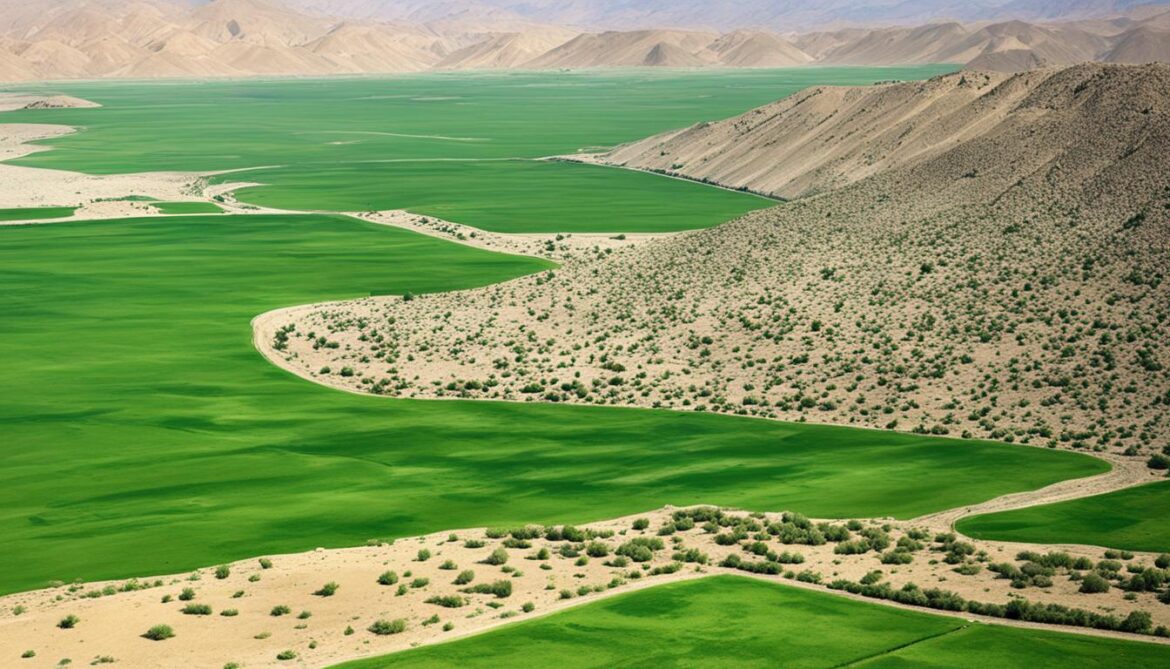
| Threats | Impact on Biodiversity |
|---|---|
| Land-use changes | Loss and fragmentation of habitat, displacement of species |
| Urbanization | Destruction of natural habitats, disruption of ecological interactions |
| Agricultural expansion | Conversion of ecosystems, loss of biodiversity hotspots |
| Industrial development | Pollution, contamination of water sources, and soil degradation |
Endangered Species in Iran
Iran’s diverse ecosystem is home to a number of iconic animal species that are unfortunately at risk of extinction. These endangered species are crucial for maintaining the balance of Iran’s biodiversity and require urgent attention through wildlife conservation efforts.
Asiatic Cheetah
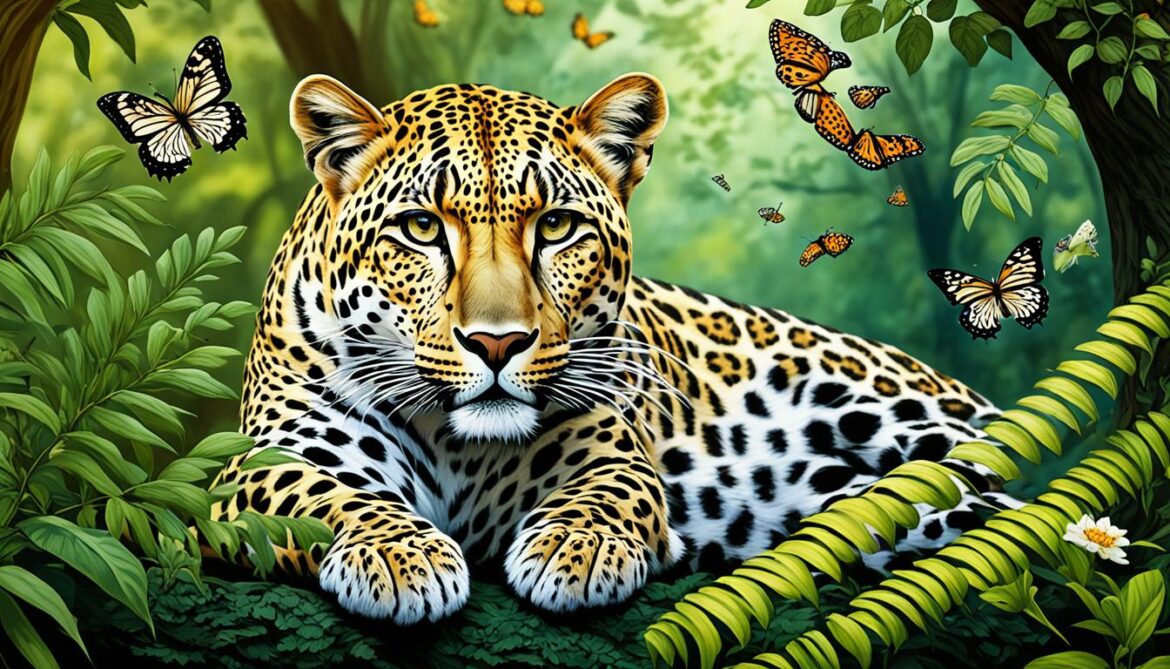 Iran is one of the last strongholds for the critically endangered Asiatic Cheetah, also known as the Iranian Cheetah. With less than 50 individuals remaining in the wild, the conservation of this majestic big cat is of utmost importance. Habitat loss and fragmentation, coupled with poaching, are major threats to the survival of the Asiatic Cheetah.
Iran is one of the last strongholds for the critically endangered Asiatic Cheetah, also known as the Iranian Cheetah. With less than 50 individuals remaining in the wild, the conservation of this majestic big cat is of utmost importance. Habitat loss and fragmentation, coupled with poaching, are major threats to the survival of the Asiatic Cheetah.
Persian Leopard
The Persian Leopard, another endangered species found in Iran, is facing similar challenges. Habitat destruction driven by human activities and poaching pose significant risks to this elusive predator’s population. Efforts are underway to protect and restore leopard habitats and raise awareness about their conservation.
“The preservation of these endangered species and their habitats is crucial for the long-term health and stability of Iran’s biodiversity.”
Gorgan Mountain Salamander
The Gorgan Mountain Salamander, endemic to Iran’s Alborz Mountains, is listed as critically endangered. Its limited distribution and habitat degradation due to deforestation and urbanization contribute to the species’ vulnerability. Conservation initiatives aim to safeguard their habitats and raise awareness about the importance of protecting these unique amphibians.
Persian Sturgeon
The Persian Sturgeon, an ancient fish species found in Iran’s Caspian Sea, is critically endangered. Overfishing, pollution, and the construction of dams are threatening its population. Conservation efforts focus on sustainable fishing practices and the restoration of spawning grounds to ensure the survival of this vital species.
It is essential to prioritize wildlife conservation and protect these endangered species and their habitats. Through collaborative efforts and sustainable practices, we can safeguard Iran’s biodiversity and secure a future where these iconic animals thrive.
Conservation Initiatives in Iran
The Iranian government is taking proactive steps to safeguard Iran’s biodiversity through various conservation efforts.
One of the significant commitments is the expansion of the protected areas network. Currently covering 11% of the land, the government aims to increase this to 20%. These protected areas play a crucial role in conserving Iran’s biodiversity by providing a safe haven for endangered species and preserving their habitats. By designating specific regions as protected areas, the government ensures the long-term viability of diverse ecosystems and the species that rely on them.
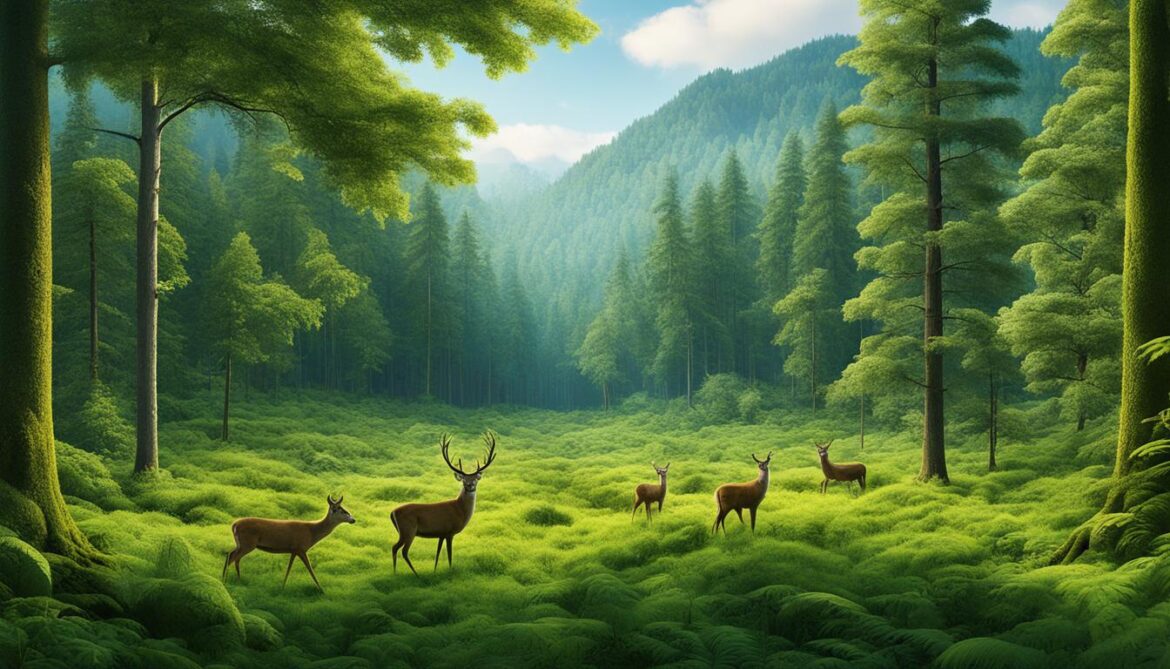
The establishment of protected areas is considered an essential conservation strategy to safeguard Iran’s rich biodiversity.
Additionally, organizations like the Wildlife Conservation Society (WCS) are actively collaborating with the Iranian government and other partners to support conservation projects. The WCS, renowned for its expertise in wildlife conservation, brings valuable knowledge and resources to foster sustainable initiatives in Iran. By working together, these collaborations contribute to the preservation of Iran’s unique wildlife and ecosystems.
Conservation Efforts and their Impact
The efforts to expand protected areas and foster collaborative conservation projects have yielded significant results. These initiatives have helped protect crucial habitats for endangered species such as the Asiatic Cheetah, Persian Leopard, and Persian Sturgeon. Through rigorous monitoring, research, and community engagement, conservation practitioners have been able to ensure the survival and recovery of these threatened species in their natural environments.
Conservation efforts in Iran are vital to protect and conserve the country’s unique biodiversity for future generations.
Moreover, by safeguarding habitats within protected areas, conservation initiatives contribute to the overall health and resilience of ecosystems. These efforts help maintain the delicate balance between plant and animal species and ensure the sustained provision of ecosystem services such as pollination, soil fertility, and water regulation.
Future Outlook
The continued commitment of the Iranian government and the active involvement of organizations like the Wildlife Conservation Society provide an optimistic outlook for the future of biodiversity conservation in Iran. The expansion of protected areas and collaborative projects not only protect endangered species but also foster environmental stewardship, public awareness, and sustainable practices.
By prioritizing conservation efforts and preserving Iran’s natural heritage, we can ensure a sustainable and flourishing environment for all living beings.
Hotspots for Biodiversity Conservation in Iran
Certain regions in Iran are renowned for their exceptional biodiversity, housing a wealth of unique animal and plant species. These hotspots, including the Caspian Hyrcanian forests, Elburz Range Forest Steppes, and coastal areas north of the Caspian Sea, are crucial focal points for conservation projects. Protecting these areas is of paramount importance in safeguarding endangered species and preserving Iran’s overall biodiversity.

The Caspian Hyrcanian forests, located along the southern coast of the Caspian Sea, are one of the most important areas for Iran’s biodiversity. These ancient forests are home to a diverse array of plant species, including several that are endemic to the region. Moreover, the forests provide critical habitats for various endangered animals, such as the Persian leopard and the Caspian tiger. Conservation projects in this hotspot aim to mitigate habitat destruction and poaching, ensuring the long-term survival of these iconic species.
The Elburz Range Forest Steppes, located in northern Iran, also harbor a remarkable variety of flora and fauna. The unique combination of forests, steppes, and alpine meadows in this region creates an ideal habitat for numerous endangered species, such as the Persian fallow deer and the Iranian yellow deer. Conservation efforts here focus on habitat restoration and the establishment of protected areas to prevent further degradation and loss of biodiversity.
“The coastal areas north of the Caspian Sea are invaluable in terms of their biodiversity. These habitats provide nesting grounds and feeding areas for a multitude of migratory bird species. These coastal wetlands are vital stopover points for birds on their long journeys, and their preservation is crucial for maintaining the delicate ecological balance.”
Conservation initiatives in these hotspots involve a combination of measures, including the establishment of protected areas, habitat restoration, and raising awareness among local communities about the importance of biodiversity conservation. Collaboration between government agencies, non-governmental organizations, and local stakeholders is crucial to ensure the success and sustainability of these projects.
Conservation Benefits Beyond Borders
The conservation efforts focused on these biodiversity hotspots in Iran not only contribute to protecting the country’s unique flora and fauna but also have broader conservation implications. Many of the species found in these hotspots are migratory, spanning multiple countries. By prioritizing the conservation of these crucial habitats, Iran actively engages in global biodiversity conservation and plays its part in maintaining the interconnectedness of ecosystems across borders.
The Need for Connectivity and Corridors
Maintaining connectivity between fragmented habitats is crucial for the long-term survival of wildlife populations in Iran. Dispersal corridors play a vital role in allowing animals to move between habitat fragments, ensuring gene flow and promoting species resilience.
Conservation projects in Iran should prioritize the preservation and creation of habitat corridors to facilitate the movement of species and enhance overall biodiversity conservation.
By establishing and safeguarding habitat connectivity, we can mitigate the negative effects of habitat fragmentation and provide essential pathways for wildlife to disperse, find mates, and access resources.
Without a well-connected network of habitats, isolated populations face increased risks of genetic inbreeding, reduced genetic diversity, and a higher susceptibility to disease and other environmental pressures.
Creating corridors is particularly critical for species that require large home ranges or have specific migration patterns. These corridors serve as lifelines, enabling animals to traverse the landscape and find suitable habitats.
Moreover, connectivity initiatives benefit not only wildlife but also humans. Well-designed connectivity projects can enhance ecosystem services, such as pollination and pest control, while promoting the sustainable management of natural resources.
Protecting and Restoring Key Linkages
Identifying and protecting important biodiversity linkages is an essential step in preserving Iran’s ecological connectivity. These linkages can include riparian corridors, forested areas, mountain ranges, or other critical habitat features.
Restoring and reforesting degraded areas to bridge existing gaps and connecting fragmented landscapes is another vital measure. This restores natural pathways for wildlife movement and allows for the exchange of genetic material necessary for population health.
Collaboration between government agencies, local communities, and conservation organizations is vital for the successful implementation of connectivity projects. By working together, we can secure the long-term survival of Iran’s iconic wildlife and maintain the ecological integrity of the country’s landscapes.

Demonstrating the Benefits
Scientific research provides evidence of the positive impacts of connectivity initiatives on wildlife populations and ecosystems.
For example, in Spain’s Cantabrian Mountains, the establishment of wildlife corridors allowed the endangered Cantabrian brown bear population to expand its range and successfully breed with neighboring populations.
In North America, the Yellowstone to Yukon Conservation Initiative aims to protect and restore connectivity across a vast landscape, benefiting wide-ranging species like grizzly bears and wolves.
These success stories highlight the importance of connectivity in enhancing species resilience, promoting genetic diversity, and safeguarding critical habitats.
| Benefits of Connectivity and Corridors | Examples |
|---|---|
| Promotes genetic diversity | Yellowstone to Yukon Conservation Initiative |
| Facilitates species adaptation to climate change | The European Green Belt |
| Enhances ecosystem services | Hoh Xil National Nature Reserve, China |
Impacts of Climate Change on Iran’s Biodiversity
Climate change poses significant challenges to Iran’s biodiversity. The country’s diverse ecosystems and unique wildlife are under threat from rising temperatures, changing rainfall patterns, and more frequent extreme weather events. These impacts can disrupt ecosystems and have far-reaching consequences for the distribution and abundance of species.
As temperatures continue to rise, certain habitats may become unsuitable for certain species, leading to shifts in their geographic range. This can result in changes to the composition of plant and animal communities and the potential loss of endemic species that are particularly adapted to specific climatic conditions.
Additionally, changes in precipitation patterns can affect the availability of water resources and alter the flowering and fruiting patterns of plants. This, in turn, can disrupt food availability for herbivores and impact the entire food chain. For example, reduced water availability in freshwater ecosystems can negatively impact fish populations and put species like the Persian Sturgeon at risk.
“Climate change is a formidable conservation challenge for Iran. The changing climate patterns pose threats not only to individual species but also to the delicate balance of ecosystems. Urgent action is needed to mitigate these impacts and preserve Iran’s unique biodiversity.” – Dr. Mohammad Reza Mirzaei, Environmental Scientist
Extreme weather events such as droughts, floods, and storms can cause direct mortality of organisms and lead to habitat destruction. For example, intense storms can erode coastal areas, affecting nesting sites for marine turtles and disrupting the delicate balance of marine ecosystems.
Conservation efforts in Iran must address the long-term effects of climate change to safeguard the country’s biodiversity. Strategies should incorporate measures to mitigate greenhouse gas emissions, promote sustainable land and water management practices, and increase the resilience of ecosystems to climate change impacts.
Examples of Climate Change Impacts on Iran’s Biodiversity
| Climate Change Impact | Examples |
|---|---|
| Shifts in species distribution | The Asiatic Cheetah’s habitat becoming less suitable due to increased aridity. |
| Changes in phenology | Delayed flowering of plants due to altered precipitation patterns. |
| Habitat destruction | Coastal erosion and loss of nesting sites for marine turtles. |
| Reduced food availability | Decline in fish populations due to reduced water flow in rivers and streams. |
Addressing the conservation challenges posed by climate change requires collaboration between government agencies, scientific institutions, and local communities. By implementing adaptive management strategies and promoting sustainable practices, Iran can ensure the long-term survival of its diverse array of species and maintain the integrity of its invaluable ecosystems.
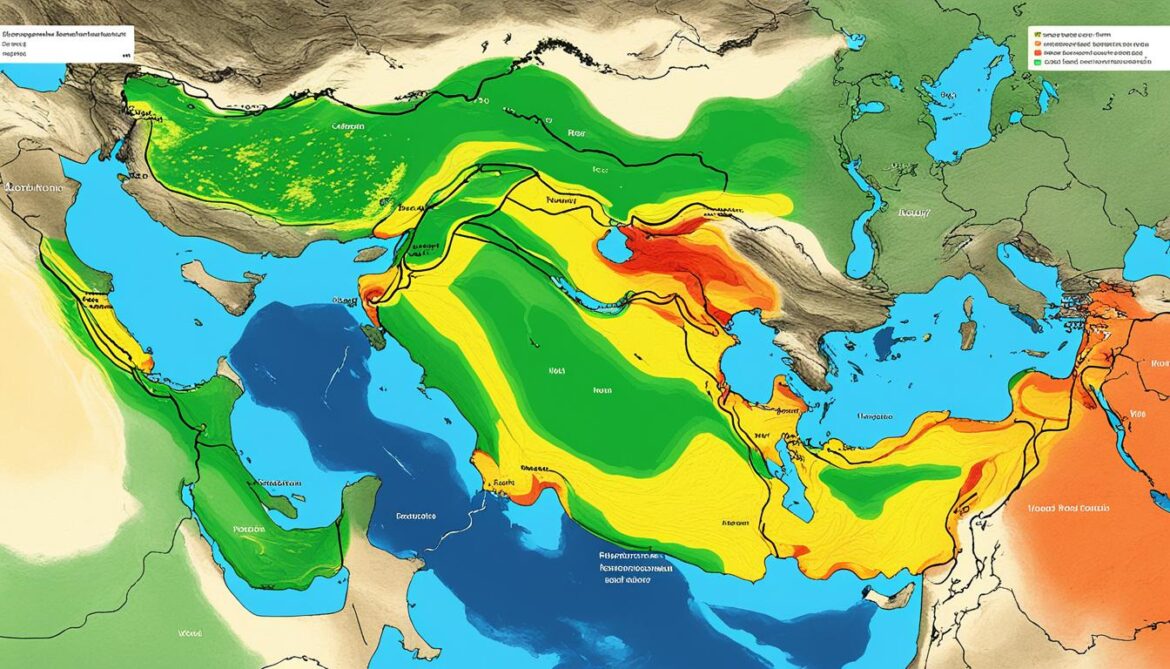
Conclusion
Protecting and preserving Iran’s rich biodiversity is crucial for the continued existence of unique animal and plant species. Conservation efforts play a vital role in addressing the threats facing Iran’s biodiversity and ensuring a thriving and sustainable future for the country’s wildlife and ecosystems.
By expanding protected areas, we can provide safe havens for endangered species and safeguard their habitats from further degradation. Additionally, habitat restoration projects help to reverse the damage caused by human activities and create conducive environments for biodiversity to flourish.
Implementing sustainable practices is another key aspect of conservation efforts. By adopting responsible land-use practices, minimizing pollution, and promoting sustainable development, we can reduce the negative impacts on Iran’s biodiversity and support the long-term well-being of its ecosystems.
Together, through collaborative efforts and a shared commitment to conservation, we can make a significant difference in protecting Iran’s biodiversity, preserving endangered species, and securing a vibrant natural heritage for future generations to enjoy.
FAQ
What is Iran’s biodiversity?
Why is Iran’s biodiversity important?
What are the threats to Iran’s biodiversity?
Which species are endangered in Iran?
What conservation initiatives are taking place in Iran?
Which regions in Iran are biodiversity hotspots?
Why is habitat connectivity important for biodiversity conservation?
How does climate change impact Iran’s biodiversity?
What is the importance of conservation efforts for Iran’s biodiversity?
Source Links
- https://www.nature.com/articles/s41598-023-45120-4
- https://www.cambridge.org/core/journals/iranian-studies/article/conservation-of-biodiversity-in-iran-threats-challenges-and-hopes/40045A96655CF158012B657B35CE567F
- https://theconversation.com/mapping-irans-biodiversity-hotspots-to-create-new-protected-areas-covering-20-of-the-landscape-198988




